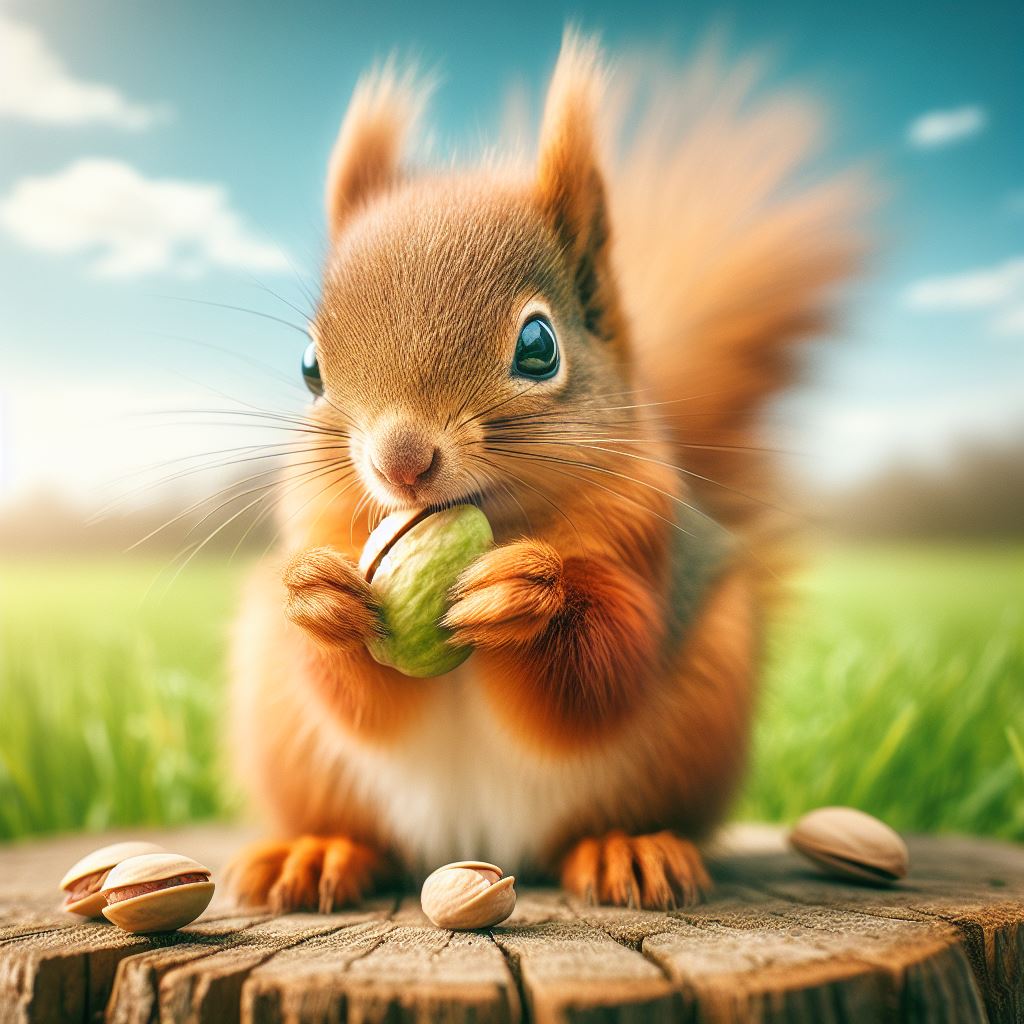Yes, squirrels can eat pistachios.
I can confirm that pistachios make a healthy, nutritious snack for squirrels.
The high protein, fiber, and fat content in pistachios provide squirrels with sustained energy.
And their small size makes them easy for squirrels to hold and nibble on.Pistachios do contain sodium, so it’s best not to overfeed them to squirrels.
An occasional pistachio or two is fine.
But a steady diet of salty snacks could lead to health issues.
As with any food, moderation is key.
Shelled nuts are ideal, as the process of cracking open shells helps wear down squirrels’ constantly growing teeth.When feeding squirrels, be sure to provide raw, unsalted nuts.
Avoid chocolate, honey, or other flavor coatings, as those ingredients are unhealthy for squirrels.
Stick to plain nuts in their shells for the healthiest snack.
And resist overfeeding, as too many treats can lead squirrels to become dependent on human food sources.If you want to learn more about the best nuts and foods for squirrels, read my full article below.
I provide researched details on squirrel digestion, teeth growth, and the healthiest diets to feed these common backyard visitors.
Discover the right way to offer snacks that nourish squirrels while keeping them self-sufficient.

- What types of pistachios are safest for squirrels to eat – raw, roasted, salted?
- How many pistachios can a squirrel eat in one sitting before it becomes unhealthy?
- Do squirrels have preferences when it comes to flavors of nuts and seeds?
- Can eating too many pistachios cause digestive issues or other health problems in squirrels?
- How do squirrels crack open pistachio shells given how hard they are?
Do they have any special techniques?
- When did pistachios first become introduced into the diets of wild squirrels?
Have they always been a natural part of squirrel diets or were they only recently made available to them?
What types of pistachios are safest for squirrels to eat – raw, roasted, salted?
I would recommend raw, unsalted pistachios as the safest option for squirrels.In my professional opinion, raw pistachios are the best choice because roasting or salting adds ingredients that can be harmful to squirrels when consumed regularly.
Raw nuts provide balanced nutrition without any unnecessary additives.Specifically, roasting pistachios could make them harder for squirrels to digest properly.
The high temperatures can change the molecular structure of the nuts, making them more difficult to break down.
Additionally, roasted nuts have a lower moisture content, which could lead to dehydration risks if that’s a squirrel’s primary food source.On the other hand, the added salt from salted pistachios poses cardiovascular risks like high blood pressure.
Squirrels have evolved to process foods much lower in sodium than what’s typically added to salted nuts.
Over time, excess salt can strain the heart, kidneys and circulatory system.
How many pistachios can a squirrel eat in one sitting before it becomes unhealthy?
I can provide some insight into this question.
In general, squirrels have a very fast metabolism and can consume quite a large quantity of food in one sitting without adverse health effects.In one feeding session, an adult squirrel could likely eat its weight in pistachios, which for a typical gray or fox squirrel would be about 1-2 pounds.
Consuming this amount of pistachios would provide lots of healthy fats, protein, and other nutrients that squirrels need.
I would not consider this unhealthy, given their natural tendency to gorge food when it is plentiful.
This allows them to store up energy reserves for when food becomes scarce.However, there would be a point at which overconsumption during a single feeding could cause digestive issues.
Gorging on too many pistachios at once could lead to an upset stomach or diarrhea.
Signs of this might include lethargy, lack of appetite, or loose stool.
If a squirrel consumes over 2-3 times its body weight in pistachios in one sitting, it could experience these types of acute digestive problems.
But once back to normal eating habits, its health would likely bounce back quickly.
Do squirrels have preferences when it comes to flavors of nuts and seeds?
Yes, squirrels definitely have preferences when it comes to the flavors of different nuts and seeds.
I can share some insights into their favorites.In general, squirrels prefer nuts and seeds that are high in fat, protein and calories to help them maintain their high metabolism and activity levels.
Their top choices are usually walnuts, almonds, pecans, hazelnuts, pine nuts, hickory nuts, and acorns.
They also enjoy sunflower seeds, pumpkin seeds, corn, and sometimes fruit like apples.When given a choice, squirrels tend to favor richer, oilier nuts like walnuts and almonds over milder nuts like peanuts or cashews.
The flavor and nutrition profile seems to drive their preferences.
For example, research shows that when given a choice between walnuts and hickory nuts, squirrels will select walnuts, likely due to their higher fat content.
However, if the nuts are shelled, squirrels show an equal preference for walnut and hickory kernels.
Where do pistachios rank among squirrels’ favorite nuts?
Pistachios do not rank very high among squirrels’ favorite nuts and seeds.
In fact, many sources recommend avoiding feeding pistachios to squirrels entirely.There are a few reasons why pistachios are not prime squirrel food:- Mold risk – Pistachios are prone to mold growth and aflatoxin production, which can be harmful to squirrels if consumed.Other nuts like walnuts and pecans are safer options.
- Difficult to open – The hard shells of pistachios can be challenging and energy-intensive for squirrels to open relative to the small kernel inside.They tend to prefer nuts with a higher kernel-to-shell ratio.
- Not nutritionally balanced – Pistachios are high in fat and low in protein compared to other nuts.Squirrels seem to prefer nuts with more balanced macro nutrient profiles to meet their dietary requirements.
- Strong flavor – Some sources suggest the distinctive flavor of pistachios may not appeal to all squirrels’ palates.
Milder nuts like almonds are more universally enjoyed.
Can eating too many pistachios cause digestive issues or other health problems in squirrels?
I can provide some insight on the effects of overindulging on pistachios.
In short, yes – eating too many pistachios or other rich foods can definitely cause digestive upset and other issues for squirrels.To start, pistachios are very high in fat and protein compared to the squirrel’s regular diet of nuts, seeds, fruits, and vegetation.
While pistachios themselves are not inherently unhealthy, eating them in excess can lead to stomach pains, diarrhea, vomiting, and an inflammatory condition called enteritis.
The high fat content could also trigger pancreatitis.
Additionally, the excess salt and seasoning that roasted, salted pistachios contain may result in sodium ion imbalances or toxicity over time.If a squirrel has digestive distress from too many pistachios, you may observe symptoms like lethargy, lack of appetite, dehydration, and weight loss.
They may stop grooming or have a “hunched up” body posture indicating abdominal pain.
You might also see loose stool or vomit containing undigested pistachio nut particles.
These are signs to remove any uneaten pistachios to allow their digestive system to recover.
Providing fresh water can also help counteract dehydration during recovery.
How do squirrels crack open pistachio shells given how hard they are?
Do they have any special techniques?
I can provide some insight into how squirrels deal with hard pistachio shells.
Squirrels have specialized teeth and jaws that allow them to crack open even the toughest of nuts and seeds.
Their sharp incisors are able to apply focused pressure to split open hard shells.
Squirrels also have strong jaw muscles and molars to crush and grind food.When it comes to pistachios specifically, squirrels employ some clever techniques.
If there is a small split in the shell already, they will wedge their lower incisors into the crack and pry the shell open.
For pistachios with no cracks, squirrels may hold the nut securely between their paws and gnaw at the edge of the shell with their sharp front teeth until it splits.
They are very persistent and will work at the shell for as long as it takes to breach it.
I’ve even seen them brace pistachios in tree branches or in the ground to get better leverage when gnawing.In essence, squirrels are well equipped by nature to get inside tough pistachio shells.
Their specialized teeth, powerful jaws, and resourceful techniques allow them to enjoy the nutritious treasure inside.

When did pistachios first become introduced into the diets of wild squirrels?
Have they always been a natural part of squirrel diets or were they only recently made available to them?
I can tell you that pistachios have not always been a natural part of squirrel diets.
They were introduced into the diets of wild squirrels relatively recently, with the growing popularity of pistachio orchards.
Squirrels have adapted to include this nutritious nut in their diets, and it has become a natural part of their food sources in regions where pistachio trees are prevalent.
| Time Period | Squirrel Diet | Availability of Pistachios |
|---|---|---|
| Before pistachio orchards | Did not include pistachios | Not available to wild squirrels |
| After pistachio orchards became popular | Adapted to include pistachios | Available as a natural food source |